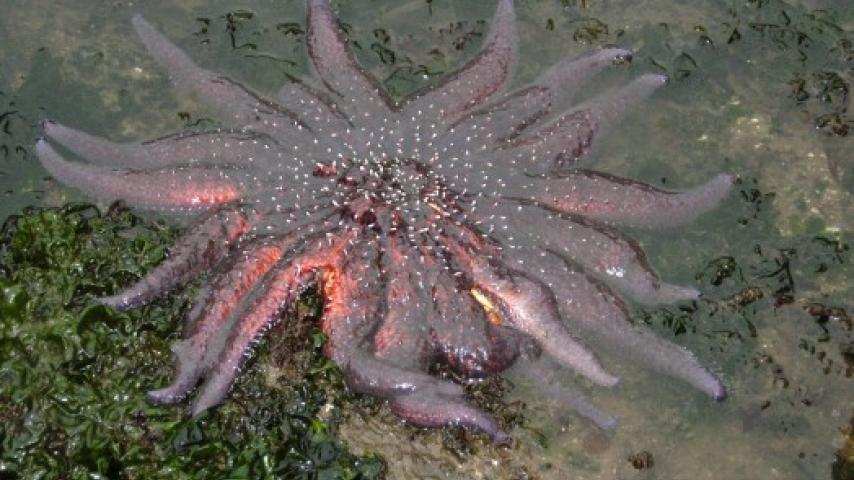Sunflower Star (Pycnopodia helianthoides)
Sea stars are abundant and diverse in Pacific Northwest marine waters.

KINGDOM Animalia - PHYLUM Echinodermata - CLASS Asteroidea - ORDER Forcipulatida - FAMILY Asteriidae
This giant species, the largest in the world, is one of the most impressive. It is not only the heaviest, but it is apparently one of the softest and swiftest sea stars. Pick one up, and it will droop, very different from the stiff Ochre Sea Star often found with it. It has an internal skeleton of spines, but they are not linked together as they are in most other sea stars.
The largest Sunflower Stars grow to a whopping 90 cm in diameter. The disk itself can be 40 cm in diameter, and up to 24 rays (arms) extend out from the disk. Juveniles start with five rays, and more are added as they grow. The color on top (aboral side) is usually purplish to orange to reddish brown, the oral side paler.
Sunflower Stars are common in the subtidal zone down to considerable depths but are easy to find in the lower intertidal when you can search it on days with especially low tides. They can be watched as they sometimes travel up to 2-3 meters per minute, a rather phenomenal speed for an echinoderm. Like the Ochre Sea Star, Sunflowers eat just about anything, but they seem even more voracious and predatory and because of their speed, literally run down their prey.
The prey of this and other large sea stars is amazingly variable, including mollusks of all kinds, other sea stars and urchins, crustaceans, and octopus. Although sea urchins are formidable prey, the sea star makes an easy meal of them, and spine punctures quickly heal. This species swallows its prey whole rather than protruding its stomach outside to digest it as is done by many other sea stars.
It’s easy to see what one of these monsters is eating when you find it. If there is a big bulge in the middle of the disk, there may be prey underneath being swallowed. One Sunflower Star when turned over had the tail of a rat protruding from its mouth. Presumably this was scavenged, not stalked up a sea wall!
It is easy to show how just the potential presence of this predator affects their prey species. Squeeze a little juice from a Pycnopodia into a marine aquarium with a variety of local species. File shells and scallops will shoot across the aquarium. Cockles will extend their foot and flip their shell over, presumably away from the sea star if they knew its direction. Abalones will twist their shell to dislodge the tube feet of an approaching Sunflower Star and will move away at a remarkable pace for an abalone.
Sunflower Stars have been seen spawning by standing up on their ray tips and releasing gametes that spread over the substrate. The eggs after fertilization develop into bilaterally symmetrical larvae called bipinnaria. At seven weeks they have undergone metamorphosis into a brachiolaria larva, which has three arms and soon drops to the substrate and turns into a miniature sea star.
Their speed allows them great mobility, and marked Sunflower Stars have moved up to 3 km in one direction. They obviously represent a formidable force in local marine communities.


